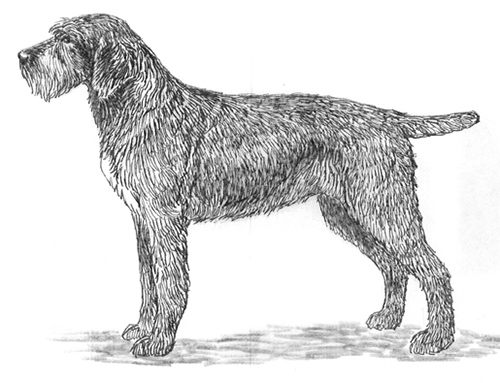German Rough Haired Pointer
Gun Dog Group
The goals and purposes of this breed standard include: to furnish guidelines for breeders who wish to maintain the quality of their breed and to improve it; to advance this breed to a state of similarity throughout the world; and to act as a guide for judges.
Breeders and judges have the responsibility to avoid any conditions or exaggerations that are detrimental to the health, welfare, essence and soundness of this breed, and must take the responsibility to see that these are not perpetuated.
Any departure from the following should be considered a fault, and the seriousness with which the fault should be regarded should be in exact proportion to its degree and its effect upon the health and welfare of the dog and on the dog’s ability to perform its traditional work.
History
The oldest German rough coated pointing dog, protected by its breed club since 1892 and not interbred with any of the English pointing breeds.
The German Rough Haired Pointer was recognized by the United Kennel Club in 2006.
General Appearance
A strong pointing dog of medium to large size, with a stiff, hard coat, moderate beard and pronounced eyebrows that give the dog a grim appearance.
Characteristics
Calm, courageous but self controlled, neither shy nor aggressive.
Head
SKULL
The skull is broad and slightly rounded. Seen from the side, the highest point of the arch is in the center of the skull. The occiput is not too pronounced.
MUZZLE
Long and powerful, not pointed. The nasal bridge is straight. The lips are dropping and close fitting, the corners forming a fold.
TEETH
The German Rough Haired Pointer has a complete set of evenly spaced, white teeth meeting in a scissors bite.
Disqualifications: Undershot, overshot, or wry mouth.
NOSE
Light to dark brown, not flesh colored.
EYES
Medium size, and slightly oval, with tight fitting rims. Brown in color, though they may be lighter in lighter colored dogs, but not yellow.
Disqualifications: Entropion or ectropion.
EARS
Medium length, with blunt, rounded tips. Set on high and hanging smoothly and closely to the head.
Neck
Medium length, clean and slightly arched, gradually widening towards the shoulders.
Forequarters
The shoulders are sloping and strongly muscled; creating an angle with the upper arm that sets the legs well back under the body.
FORELEGS
The distance from the elbow to the ground is slightly greater than the distance from the withers to the elbow. The legs are straight and strong, with straight pasterns.
Body
The body should be square, or very slightly longer than tall. The chest is deep and well developed, and the ribs are well sprung, never flat. The withers are marked, and the back is straight and strong, with the topline sloping only slightly. The loin is well muscled and the croup is slightly sloping. There is moderate tuck up.
Hindquarters
There is good angulation between the pelvis and upper thigh.
HIND LEGS
Seen from the rear, the legs are straight and parallel, with strong bone and muscles. The upper thigh is broad, and the lower thigh is long, sinewy and muscular. There is good angulation at the stifle and the hock. The rear pasterns are perpendicular.
Feet
Round, with well knit toes and tough pads.
Tail
Medium length, set on not too low, and strong at the root. Moderate docking is permitted. A natural tail should reach to the hock, and be carried straight or with some upward curve.
Coat
On the body, the coat is stiff, harsh and bristly, approximately 1½ inches long. On the shoulders and the underside of the body, it is slightly longer, with some straight feathering. Sometimes there is a barely visible undercoat on the entire body. On the muzzle there is a moderate beard. The hair on the skull is close, short and harsh. The eyebrows are bushy and stand off, forming an arch. The head should be free of any soft, wooly or silky coat. On the front of the front legs the hair is short, hard and flat. On the back of the legs there is somewhat longer feathering. The back sides of the hind legs are slightly feathered.
The tail is densely covered but there is no brush or plume.
Disqualification: Soft coat, except for beard and eyebrows.
Color
Brown, with or without a white chest patch; brown roan, with or without patches; light roan, with or without patches.
Disqualifications: Black color. Yellow or red markings on the head or legs.
Height
Height at the withers for males is 23.5 inches to 27.5 inches. For females, it is 23 to 27 inches.
Gait
Upstanding and ground covering, with plenty of reach and drive. Parallel coming and going.
Disqualifications
(A dog with a Disqualification must not be considered for placement in a conformation event, and must be reported to UKC.)
Unilateral or bilateral cryptorchid.
Viciousness or extreme shyness.
Albinism.
Undershot, overshot, or wry mouth.
Entropion or ectropion.
Soft coat, except for beard and eyebrows.
Black color.
Yellow or red markings on the head or legs.
The docking of tails and cropping of ears in America is legal and remains a personal choice. However, as an international registry, the United Kennel Club is aware that the practices of cropping and docking have been forbidden in some countries. In light of these developments, the United Kennel Club feels that no dog in any UKC event, including conformation, shall be penalized for a full tail or natural ears.

Looking for a Dog?
Find a dog that will fit your family.
Note: The breeders on this list are not endorsed by UKC.
©Copyright 2006, United Kennel Club
